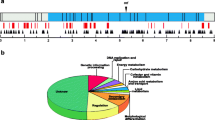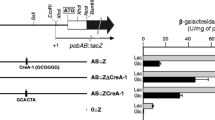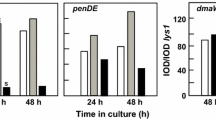Abstract
The most commonly used ß-lactam antibiotics for the therapy of infectious diseases are penicillin and cephalosporin. Penicillin is produced as end product by some fungi, most notably by Aspergillus ( Emericella) nidulans and Penicillium chrysogenum. Cephalosporins are synthesised by several bacteria and fungi, e.g. by the fungus Acremonium chrysogenum (syn. Cephalosporium acremonium). The biosynthetic pathways leading to both secondary metabolites start from the same three amino acid precursors and have the first two enzymatic reactions in common. The penicillin biosynthesis is catalysed by three enzymes encoded by acvA ( pcbAB), ipnA (pcbC) and aatA ( penDE). The genes are organised into a cluster. In A. chrysogenum, in addition to acvA and ipnA, which are also clustered, a second cluster contains the genes for enzymes catalysing the reactions of the later steps of the cephalosporin pathway (cefEF, cefG). Transcription of biosynthesis genes is subject to sophisticated control by nutritional factors (e.g. glucose, nitrogen), amino acids such as lysine and methionine, and ambient pH. Some regulators have been identified such as the A. nidulans pH regulatory protein PACC and the transcriptional complex PENR1. PENR1 is a HAP-like transcriptional complex similar or identical to AnCF. Additional positive regulatory factors seem to be represented by recessive trans-acting mutations of A. nidulans ( prgA1, prgB1, npeE1) and P. chrysogenum (carried by mutants Npe2 and Npe3). The GATA-binding factor NRE appears to be involved in the regulation of the penicillin biosynthesis genes by the nitrogen source in P. chrysogenum. Formal genetic evidence suggests the existence of transcriptional repressors as well.
Similar content being viewed by others
References
Arst HN Jr (1996) Regulation of gene expression by pH, p. 235–240. In: Brambl R & Marzluf GA (Eds) The Mycota III, Biochemistry and Molecular Biology. Springer Verlag, Berlin, Germany
Arst HN Jr, Bignell E & Tilburn J (1994) Two new genes involved in signalling ambient pH in Aspergillus nidulans. Mol. Gen. Genet. 245: 787–790
Barredo JL, Diez B, Alvarez E & Martin JF (1989) Large amplification of a 35-kb DNA fragment carrying two penicillin biosynthetic genes in high penicillin producing strains of Penicillium chrysogenum. Curr. Genet. 16: 453–459
Brakhage AA (1998) Molecular regulation of ß-lactam biosynthesis in filamentous fungi. Microbiol. Mol. Biol. Rev. 62: 547–585
Brakhage AA, Browne P & Turner G (1992) Regulation of Aspergillus nidulans penicillin biosynthesis and penicillin biosynthesis genes acvA and ipnA by glucose. J. Bacteriol. 174: 3789–3799
Brakhage AA, Browne P & Turner G (1994) Analysis of penicillin biosynthesis and the expression of penicillin biosynthesis genes of Aspergillus nidulans by targeted disruption of the acvA gene. Mol. Gen. Genet. 242: 57–64
Brakhage AA & Turner G (1992) L-Lysine repression of penicillin biosynthesis and expression of penicillin biosynthesis genes acvA and ipnA in Aspergillus nidulans. FEMS Microbiol. Lett. 98: 123–128
Brakhage AA & Turner G (1995) Biotechnical Genetics of Antibiotic Biosynthesis, pp. 263–285. In: Kück U (Ed) The Mycota II. Genetics and Biotechnology. Springer Verlag, Berlin, Germany
Brakhage AA & Van den Brulle J (1995) Use of reporter genes to identify recessive trans-acting mutations specifically involved in the regulation of Aspergillus nidulans penicillin biosynthesis genes. J. Bacteriol. 177: 2781–2788
Caddick MX, Brownlee AG & Arst HN Jr (1986) Regulation of gene expression by pH of the growth medium in Aspergillus nidulans. Mol. Gen. Genet. 203: 346–353
Cantoral JM, Gutiérrez S, Fierro F, Gil-Espinosa S, van Liempt H & Martin JF (1993) Biochemical characterisation and molecular genetics of nine mutants of Penicillium chrysogenum impaired in penicillin biosynthesis. J. Biol. Chem. 268: 737–744
Demain AL (1957) Inhibition of penicillin formation by lysine. Arch. Biochem. Biophys. 67: 244–245
DeModena JA, Gutiérrez S, Velasco J, Fernández FJ, Fachini RA, Galazzo JL, Hughes DE & Martin JF (1993) The production of cephalosporin C by Acremonium chrysogenum is improved by the intracellular expression of a bacterial hemoglobin. Bio/Technol. 11: 926–929
Diez BS, Gutiérrez S, Barredo JL, van Solingen P, van der Voort LHM & Martin JF (1990) The cluster of penicillin biosynthetic genes. Identification and characterization of the pcbAB gene encoding the α-aminoadipyl-cysteinyl-valine synthetase and linkage to the pcbC and penDE genes. J. Biol. Chem. 265: 16358–16365
Dorn G (1965) Genetic analysis of the phosphatases in Aspergillus nidulans. Genet. Res. 6: 13–26
Espeso EA & Peñalva MA (1992) Carbon catabolite repression can account for temporal pattern of expression of a penicillin biosynthetic gene in Aspergillus nidulans. Mol. Microbiol. 6: 1457–1465
Espeso EA & Peñalva MA (1996) Three binding sites for the Aspergillus nidulans PacC zinc-finger transcription factor are necessary and sufficient for regulation by ambient pH of the isopenicillin N synthase gene promoter. J. Biol. Chem. 271: 28825–28830
Espeso EA, Tilburn J, Arst HN Jr & Peñalva MA (1993) pH regulation is a major determinant in expression of a fungal biosynthetic gene. EMBO J. 12: 3947–3956
Espeso EA, Tilburn J, Sánchez-Pulido L, Brown CV, Valencia A, Arst HN Jr & Peñalva MA (1997) Specific DNA recognition by the Aspergillus nidulans three zinc finger transcription factor PacC. J. Mol. Biol. 274: 466–480
Feng B, Friedlin E & Marzluf GA (1994) A reporter gene analysis of penicillin biosynthesis gene expression in Penicillium chrysogenum and its regulation by nitrogen and glucose catabolite repression. Appl. Environm. Microbiol. 60: 4432–4439
Fernández-Cañón JM & Peñalva MA (1995) Overexpression of two penicillin structural genes in Aspergillus nidulans. Mol. Gen. Genet. 246: 110–118
Haas H, Bauer B, Redl B, Stöffler G & Marzluf GA (1995) Molecular cloning and analysis of nre, the major nitrogen regulatory gene of Penicillium chrysogenum. Curr. Genet. 27: 150–158
Haas H & Marzluf GA (1995) NRE, the major nitrogen regulatory protein of Penicillium chrysogenum binds specifically to elements in the intergenic promoter regions of nitrate assimilation and penicillin biosynthetic gene clusters. Curr. Genet. 28: 177–183
Hoskins JA, O'Callaghan N, Queener SW, Cantwell CA, Wood JS, Chen VJ & Skatrud PL (1990) Gene disruption of the pcbAB gene encoding ACV synthetase in Cephalosporium acremonium. Curr. Genet. 18: 523–530
Kennedy J & Turner G (1996) δ-(L-α-Aminoadipyl)-L-cysteinyl-D-valine synthetase is a rate limiting enzyme for penicillin production in Aspergillus nidulans. Mol. Gen. Genet. 253: 189–197
Kück U, Walz M, Mohr G & Mracek M (1989) The 5′-sequence of the isopenicillin N-synthetase gene (pcbC) from Cephalosporium acremonium directs the expression of the prokaryotic hygromycin B phosphotransferase gene (hph) in Aspergillus niger. Appl. Microbiol. Biotechnol. 31: 358–365
Litzka O, Papagiannopoulos P, Davis MA, Hynes MJ & Brakhage AA (1998) The penicillin regulator PENR1 of Aspergillus nidulans is a HAP-like transcriptional complex. Eur. J. Biochem. 251: 758–767
Litzka O, Then Bergh K & Brakhage AA (1995) Analysis of the regulation of Aspergillus nidulans penicillin biosynthesis gene aat (penDE) encoding acyl coenzyme A:6-aminopenicillanic acid acyltransferase. Mol. Gen. Genet. 249: 557–569
Litzka O, Then Bergh K & Brakhage AA (1996) The Aspergillus nidulans penicillin biosynthesis gene aat (penDE) is controlled by a CCAAT containing DNA element. Eur. J. Biochem. 238: 675–682
MacCabe AP, van Liempt H, Palissa H, Unkles SE, Riach MBR, Pfeifer E, von Döhren H & Kinghorn JR (1991) δ-(L-α-Aminoadipyl)-L-cysteinyl-D-valine synthetase from Aspergillus nidulans — Molecular characterization of the acvA gene encoding the first enzyme of the penicillin biosynthetic pathway. J. Biol. Chem. 266: 12646–12654.
Martin JF, Gutiérrez S & Demain AL (1997) ß-Lactams, p. 91–127. In: Anke T (Ed) Fungal Biotechnology. Antibiotics. Chapman and Hall, Weinheim
Marzluf GA (1997) Genetic regulation of nitrogen metabolism in the fungi. Microbiol. Mol. Biol. Rev. 61: 17–32
Mathison L, Soliday C, Stepan T, Aldrich T & Rambosek J (1993) Cloning, characterization, and use in strain improvement of the Cephalosporium acremonium gene cefG encoding acetyl transferase. Curr. Genet. 23: 33–41
Matsuda A, Sugiura H, Matsuyama K, Matsumoto H, Ichikawa S & Komatsu K-I (1992) Cloning and disruption of the cefG gene encoding acetyl coenzyme A: deacetylcephalosporin C O-acetyltransferase from Acremonium chrysogenum. Biochem. Biophys. Res. Commun. 186: 40–46
McNabb DS, Xing Y & Guarente L (1995) Cloning of yeast HAP5: a novel subunit of a heterotrimeric complex required for CCAAT binding. Genes Dev. 9: 47–58
Menne S, Walz M & Kück U (1994) Expression studies with the bidirectional pcbAB-pcbC promoter region from Acremonium chrysogenum using reporter gene fusions. Appl. Microbiol. Biotechnol. 42: 57–66
Newbert RW, Barton B, Greaves P, Harper J & Turner G (1997) Analysis of a commercially improved Penicillium chrysogenum strain series: Involvement of recombinogenic regions in amplification and deletion of the penicillin biosynthesis gene cluster. J. Ind. Microbiol. Biotechnol. 19: 18–27
Orejas M, Espeso EA, Tilburn J, Sarkar S, Arst HN Jr & Peñalva MA (1995) Activation of the Aspergillus PacC transcription factor in response to alkaline ambient pH requires proteolysis of the carboxy-terminal moiety. Genes Devel. 9: 1622–1632
Papagiannopoulos P, Andrianopoulos A, Sharp JA, Davis MA & Hynes MJ (1996) The hapC gene of Aspergillus nidulans is involved in the expression of CCAAT-containing promoters. Mol. Gen. Genet. 251:412–421
Pérez-Esteban B, Gómez-Pardo E & Peñalva MA (1995) A lacZ reporter fusion method for the genetic analysis of regulatory mutations in pathways of fungal secondary metabolism and its application to the Aspergillus nidulans penicillin pathway. J. Bacteriol. 177: 6069–6076
Pérez-Esteban B, Orejas M, Gómez-Pardo E & Peñalva MA (1993) Molecular characterization of a fungal secondary metabolism promoter: transcription of the Aspergillus nidulans isopenicillin N synthetase gene is modulated by upstream negative elements. Mol. Microbiol. 9: 881–895
Ramos FR, López-Nieto MJ & Martin JF (1986) Coordinate increase of isopenicillin N synthetase, isopenicillin N epimerase and deacetoxycephalosporin C synthetase in a high cephalosporin-producing mutant of Acremonium chrysogenum and simultaneous loss of the three enzymes in a non-producing mutant. FEMS Microbiol. Lett. 35: 123–127
Ramsden M, McQuade BA, Saunders K, Turner MK & Harford S (1989) Characterization of a loss-of-function mutation in the isopenicillin N synthetase gene of Acremonium chrysogenum. Gene 85: 267–273
Renno DV, Saunders G, Bull AT & Holt G (1992) Transcript analysis of penicillin genes from Penicillium chrysogenum. Curr. Genet. 21: 49–54
Shah AJ, Tilburn J, Adlard MW & Arst HN Jr (1991) pH regulation of penicillin production in Aspergillus nidulans. FEMS Microbiol. Lett. 77: 209–212
Skatrud PL, Tietz AJ, Ingolia TD, Cantwell CA, Fisher DL, Chapman JL & Queener SW (1989) Use of recombinant DNA to improve production of cephalosporin C by Cephalosporium acremonium. Bio/Technol. 7: 477–485
Smith DJ, Bull JH, Edwards J & Turner G (1989) Amplification of the isopenicillin N synthetase gene in a strain of Penicillium chrysogenum producing high levels of penicillin. Mol. Gen. Genet. 216: 492–497
Smith DJ, Burnham MRK, Bull JH, Hodgson JE, Ward JM, Browne P, Brown J, Barton B, Earl AJ & Turner G (1990a) ß-Lactam antibiotic biosynthetic genes have been conserved in clusters in prokaryotes and eukaryotes. EMBO J. 9: 741–747
Smith DJ, Earl AJ & Turner G (1990b) The multifunctional peptide synthetase performing the first step of penicillin biosynthesis is a 421 073 dalton protein similar to Bacillus brevis peptide antibiotic synthetases. EMBO J. 9: 2743–2750
Suárez T & Peñalva MA (1996) Characterisation of a Penicillium chrysogenum gene encoding a PacC transcription factor and its binding sites in the divergent pcbAB-pcbC promoter of the penicillin biosynthetic cluster. Mol. Microbiol. 20: 529–540
Then Bergh K & Brakhage AA (1998) Regulation of the Aspergillus nidulans penicillin biosynthesis gene acvA (pcbAB) by amino acids: Implication for involvement of transcription factor PACC. Appl. Environm. Microbiol. 64: 843–849
Then Bergh K, Litzka O & Brakhage AA (1996) Identification of a major cr's-acting DNA element controlling the bidirectionally transcribed penicillin biosynthesis genes acvA (pcbAB) and ipnA (pcbC) of Aspergillus nidulans. J. Bacteriol. 178: 3908–3916
Tilburn J, Sarkar S, Widdick DA, Espeso EA, Orejas M, Mungroo J, Peñalva MA & Arst HN Jr (1995) The Aspergillus PacC zinc finger transcription factor mediates regulation of both acidic-and alkaline-expressed genes by ambient pH. EMBO J. 14: 779–790
Veenstra AE, van Solingen P, Bovenberg RAL & van der Voort LHM (1991) Strain improvement of Penicillium chrysogenum by recombinant DNA techniques. J. Biotechnol. 17: 81–90
Velasco J, Gutiérrez S, Fernandez FJ, Marcos AT, Arenos C & Martin JF (1994) Exogenous methionine increases levels of mRNAs transcribed from pcbAB, pcbC, and cefEF genes, encoding enzymes of the cephalosporin biosynthetic pathway, in Acremonium chrysogenum. J. Bacteriol. 176: 985–991
Zhang J & Demain AL (1992) Regulation of ACV synthetase activity by carbon sources and their metabolites. Arch. Microbiol. 158: 364–369
Author information
Authors and Affiliations
Corresponding author
Rights and permissions
About this article
Cite this article
Litzka, O., Bergh, K.T., den Brulle, J.V. et al. Transcriptional control of expression of fungal ß-lactam biosynthesis genes. Antonie Van Leeuwenhoek 75, 95–105 (1999). https://doi.org/10.1023/A:1001706729545
Issue Date:
DOI: https://doi.org/10.1023/A:1001706729545




